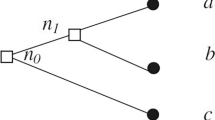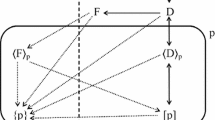Abstract
In this paper, we analyze an intra-personal game where a decision-maker is summarized by a succession of selves. Selves may (or may not) have conflicting interests, and earlier selves may have imperfect knowledge of the preferences of future selves. At date 1, self-1 chooses a menu, at date 2, the preferences of self-2 realize and self-2 chooses an item from the menu. We show that equilibrium choice is consistent with either a preference for flexibility, a preference for betweenness or a preference for systematic restriction. Overall, the analysis reconciles the decision–theoretic approach of choice over time with the game–theoretic multiple-selves approach.
Similar content being viewed by others
References
Benhabib J., Bisin A. (2005) Modelling internal commitment-mechanisms and self-control: A neuroeconomics approach to consumption-savings decisions. Games and Economic Behavior 52: 460–492
Bernheim B. D., Rangel A. (2004) Addiction and cue-triggered decision processes. American Economic Review 4(5): 1558–1590
Bénabou R., Pycia M. (2002) Dynamic inconsistency and self control: A planner-doer interpretation. Economic Letters 77(3): 419–424
Brocas I., Carrillo J. D. (2008a) Theories of the mind. American Economic Review, Papers and Proceedings 98(2): 175–180
Brocas I., Carrillo J. D. (2008b) The brain as a hierarchical organization. American Economic Review 98(4): 1312–1346
Chatterjee, K. & Krishna V. (2008). A “Dual Self” representation for stochastic temptation. American Economic Journal, Microeconomics (forthcoming).
Dekel E, Lipman B. L., Rustichini A. (2001) Representing preferences with a unique subjective state space. Econometrica 79(4): 891–934
Fudenberg D., Levine D. K. (2006) A dual self model of impulse control. American Economic Review 96: 1449–1476
Gul F., Pesendorfer W. (2001) Dynamic inconsistency and self-control. Econometrica 69(6): 1403–1436
Kreps D. (1979) A representation theorem for preference for flexibility. Econometrica 47(3): 565–578
Laibson D. (1997) Golden eggs and hyperbolic discounting. Quarterly Journal of Economics 112(2): 443–477
Nehring K. (2006) Self-control through second-order preferences. University of California Davis, Mimeo
Shefrin H., Thaler R. (1988) The behavioral life-cycle hypothesis. Economic Inquiry 26(4): 609–643
Strotz R. H. (1955) Myopia and inconsistency in dynamic utility maximization. Review of Economic Studies 23: 165–180
Thaler R., Shefrin H. M. (1981) An economic theory of self-control. Journal of Political Economy 89: 392–406
Author information
Authors and Affiliations
Corresponding author
Additional information
This research has benefited from early discussions with Marc Henry. I am also grateful to Juan Carrillo for comments.
Rights and permissions
About this article
Cite this article
Brocas, I. Dynamic inconsistency and choice. Theory Decis 71, 343–364 (2011). https://doi.org/10.1007/s11238-009-9183-x
Published:
Issue Date:
DOI: https://doi.org/10.1007/s11238-009-9183-x




